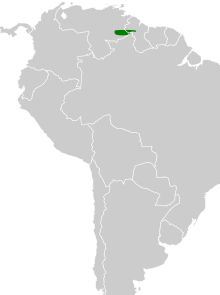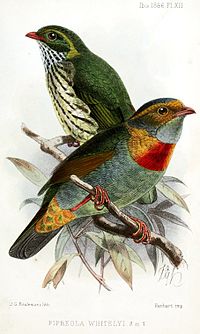31:
75:
270:
200:
50:
278:
yellowish-ochre under-tail coverts. The female has similar head markings, a yellowish patch at the side of the neck, and moss-green upper parts. There is no chest collar and the underparts are greyish-white, boldly streaked with black. The beak and legs are pinkish-grey; the male has an orange iris and the female's is ochre. The song, a high-pitched hissing trill lasting for several seconds, is seldom uttered.
294:
This bird feeds on fruit in the tree canopy, sometimes visiting forest verges (at which times it is easier to observe), but more often remaining elusive in the woodland interior. It is a lethargic bird usually seen singly or in pairs, but sometimes forming part of mixed flocks of fruiteaters. The
277:
The red-banded fruiteater grows to a length of about 16.6 cm (6.5 in). The adult male has greyish-green upper parts with a distinctive long golden stripe that runs above the eye and round the ear-coverts. The chin and belly are grey and there is a broad, orange-red chest collar, and
303:
Although the population size of the red-banded fruiteater is unknown, it is believed to be stable and the bird does not face any particular threats. Its range is large but it is generally described as being uncommon. The
286:
The red-banded fruiteater is found in the tropical forests of Guyana and
Venezuela. Its altitudinal range is from 1,200 to 2,250 metres (3,900 to 7,400 ft) above sea level.
453:
636:
772:
305:
243:
675:
752:
610:
312:", believing that it does not qualify on the range size or total population criteria for inclusion in a more threatened category.
649:
424:
394:
30:
654:
777:
449:
767:
680:
295:
fruits on which it feeds are mainly consumed while hovering briefly, but sometimes the bird perches while feeding.
762:
693:
553:
548:
513:
358:
527:
74:
459:
688:
189:
641:
535:
475:
667:
414:
384:
716:
309:
247:
169:
706:
443:
597:
540:
8:
39:
335:
69:
757:
701:
571:
420:
390:
729:
576:
353:
563:
498:
746:
662:
344:
238:. While likely present, it remains unconfirmed in adjacent parts of northern
185:
59:
54:
269:
623:
507:
258:
254:
463:
199:
724:
615:
223:
257:, the underparts of the male are primarily grey. As suggested by its
231:
226:. Its known range is restricted to the humid highland forests of the
126:
86:
628:
589:
469:
492:
146:
106:
522:
136:
602:
239:
235:
227:
96:
329:
327:
325:
584:
386:
Field Guide to the
Songbirds of South America: The Passerines
382:
322:
219:
116:
261:, the male also has a conspicuous red pectoral collar.
333:
308:has assessed its conservation status as being of "
359:10.2305/IUCN.UK.2016-3.RLTS.T22700812A93798065.en
744:
389:. University of Texas Press. pp. 504–506.
246:has rated its conservation status as being of "
412:
306:International Union for Conservation of Nature
244:International Union for Conservation of Nature
419:. Princeton University Press. p. 102.
281:
198:
48:
29:
378:
376:
357:
268:
408:
406:
383:Ridgely, Robert S.; Tudor, Guy (2009).
745:
373:
773:Taxa named by Frederick DuCane Godman
474:
473:
403:
753:IUCN Red List least concern species
345:IUCN Red List of Threatened Species
13:
14:
789:
437:
416:Birds of South America Passerines
73:
446:on the Internet Bird Collection
334:BirdLife International (2016).
264:
1:
315:
444:Red-banded Fruiteater videos
7:
778:Taxa named by Osbert Salvin
10:
794:
289:
482:
298:
197:
175:
168:
70:Scientific classification
68:
46:
37:
28:
23:
352:: e.T22700812A93798065.
282:Distribution and habitat
768:Birds described in 1884
413:van Perlo, Ber (2015).
274:
273:Red-banded fruiteaters
24:Red-banded fruiteater
272:
210:red-banded fruiteater
230:in the southeast of
763:Birds of the Tepuis
253:Uniquely among the
40:Conservation status
275:
218:) is a species of
740:
739:
730:Pipreola-whitelyi
702:Open Tree of Life
514:Pipreola whitelyi
484:Pipreola whitelyi
476:Taxon identifiers
426:978-0-691-16796-1
396:978-0-292-71748-0
338:Pipreola whitelyi
215:Pipreola whitelyi
206:
205:
179:Pipreola whitelyi
63:
785:
733:
732:
720:
719:
710:
709:
697:
696:
684:
683:
671:
670:
658:
657:
645:
644:
632:
631:
619:
618:
606:
605:
593:
592:
580:
579:
567:
566:
557:
556:
544:
543:
531:
530:
528:145B20DB9FCBA026
518:
517:
516:
503:
502:
501:
471:
470:
431:
430:
410:
401:
400:
380:
371:
370:
368:
366:
361:
331:
202:
181:
161:P. whitelyi
78:
77:
57:
52:
51:
33:
21:
20:
793:
792:
788:
787:
786:
784:
783:
782:
743:
742:
741:
736:
728:
723:
715:
713:
705:
700:
692:
687:
679:
674:
666:
661:
653:
648:
640:
635:
627:
622:
614:
609:
601:
596:
588:
583:
575:
570:
562:
560:
552:
547:
539:
534:
526:
521:
512:
511:
506:
497:
496:
491:
478:
456:tropicalbirding
440:
435:
434:
427:
411:
404:
397:
381:
374:
364:
362:
332:
323:
318:
301:
292:
284:
267:
193:
183:
177:
164:
72:
64:
53:
49:
42:
17:
16:Species of bird
12:
11:
5:
791:
781:
780:
775:
770:
765:
760:
755:
738:
737:
735:
734:
721:
711:
698:
685:
672:
659:
646:
633:
620:
607:
594:
581:
568:
558:
545:
532:
519:
504:
488:
486:
480:
479:
468:
467:
457:
450:Photo-High Res
447:
439:
438:External links
436:
433:
432:
425:
402:
395:
372:
320:
319:
317:
314:
300:
297:
291:
288:
283:
280:
266:
263:
222:in the family
204:
203:
195:
194:
184:
173:
172:
166:
165:
158:
156:
152:
151:
144:
140:
139:
134:
130:
129:
124:
120:
119:
114:
110:
109:
104:
100:
99:
94:
90:
89:
84:
80:
79:
66:
65:
47:
44:
43:
38:
35:
34:
26:
25:
15:
9:
6:
4:
3:
2:
790:
779:
776:
774:
771:
769:
766:
764:
761:
759:
756:
754:
751:
750:
748:
731:
726:
722:
718:
712:
708:
703:
699:
695:
690:
686:
682:
677:
673:
669:
664:
660:
656:
651:
647:
643:
638:
634:
630:
625:
621:
617:
612:
608:
604:
599:
595:
591:
586:
582:
578:
573:
569:
565:
559:
555:
550:
546:
542:
537:
533:
529:
524:
520:
515:
509:
505:
500:
494:
490:
489:
487:
485:
481:
477:
472:
465:
461:
458:
455:
451:
448:
445:
442:
441:
428:
422:
418:
417:
409:
407:
398:
392:
388:
387:
379:
377:
360:
355:
351:
347:
346:
341:
339:
330:
328:
326:
321:
313:
311:
310:least concern
307:
296:
287:
279:
271:
262:
260:
256:
251:
249:
248:least concern
245:
241:
237:
233:
229:
225:
221:
217:
216:
211:
201:
196:
191:
187:
182:
180:
174:
171:
170:Binomial name
167:
163:
162:
157:
154:
153:
150:
149:
145:
142:
141:
138:
135:
132:
131:
128:
127:Passeriformes
125:
122:
121:
118:
115:
112:
111:
108:
105:
102:
101:
98:
95:
92:
91:
88:
85:
82:
81:
76:
71:
67:
61:
56:
55:Least Concern
45:
41:
36:
32:
27:
22:
19:
483:
415:
385:
363:. Retrieved
349:
343:
337:
302:
293:
285:
276:
252:
234:and western
214:
213:
209:
207:
178:
176:
160:
159:
147:
18:
689:Neotropical
624:iNaturalist
508:Wikispecies
466:fieldguides
365:14 November
265:Description
259:common name
255:fruiteaters
747:Categories
725:Xeno-canto
316:References
224:Cotingidae
137:Cotingidae
232:Venezuela
155:Species:
93:Kingdom:
87:Eukaryota
758:Pipreola
668:22700812
642:10596895
541:22700812
536:BirdLife
499:Q1187252
493:Wikidata
148:Pipreola
133:Family:
107:Chordata
103:Phylum:
97:Animalia
83:Domain:
60:IUCN 3.1
717:2338329
694:rebfru1
616:2486359
590:rebfru1
564:rebfru1
523:Avibase
464:Article
454:Article
290:Ecology
143:Genus:
123:Order:
113:Class:
58: (
714:uBio:
707:946231
681:649804
655:562203
603:917014
554:116182
423:
393:
299:Status
242:. The
240:Brazil
236:Guyana
228:tepuis
192:, 1884
190:Godman
188:&
186:Salvin
637:IRMNG
585:eBird
577:6VKN2
561:BOW:
460:Photo
676:NCBI
663:IUCN
650:ITIS
629:8784
611:GBIF
549:BOLD
421:ISBN
391:ISBN
367:2021
350:2016
220:bird
208:The
117:Aves
598:EoL
572:CoL
354:doi
250:".
749::
727::
704::
691::
678::
665::
652::
639::
626::
613::
600::
587::
574::
551::
538::
525::
510::
495::
462:;
452:;
405:^
375:^
348:.
342:.
324:^
429:.
399:.
369:.
356::
340:"
336:"
212:(
62:)
Text is available under the Creative Commons Attribution-ShareAlike License. Additional terms may apply.


